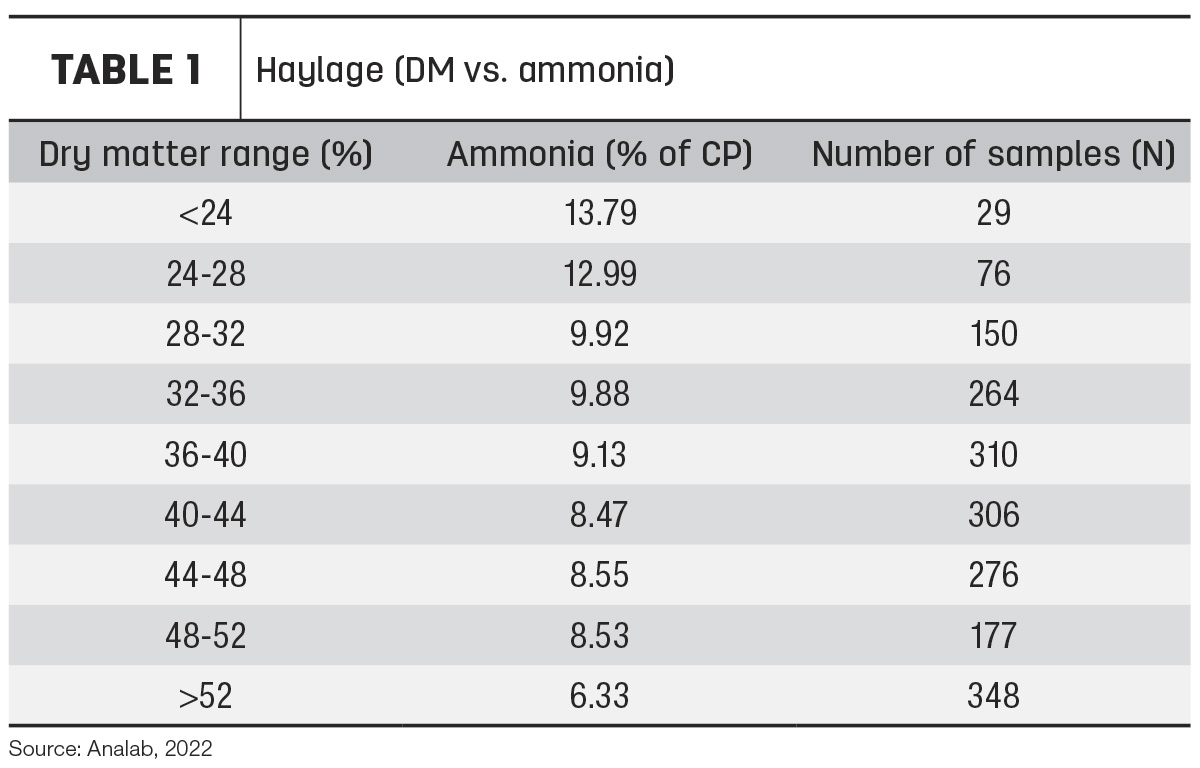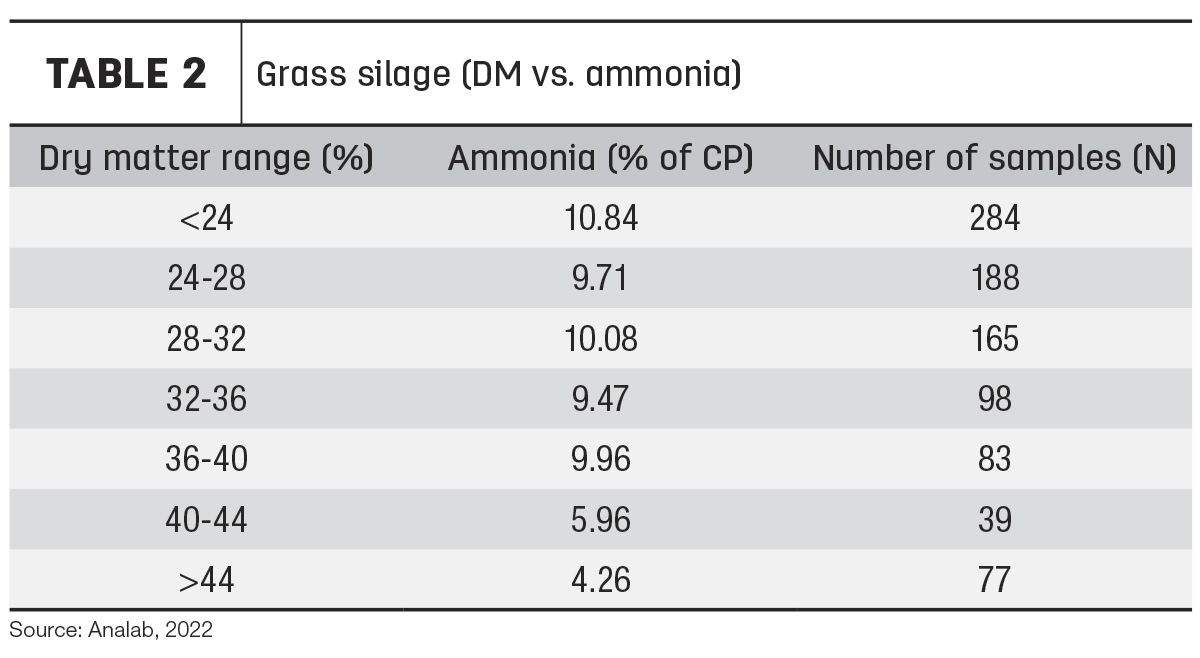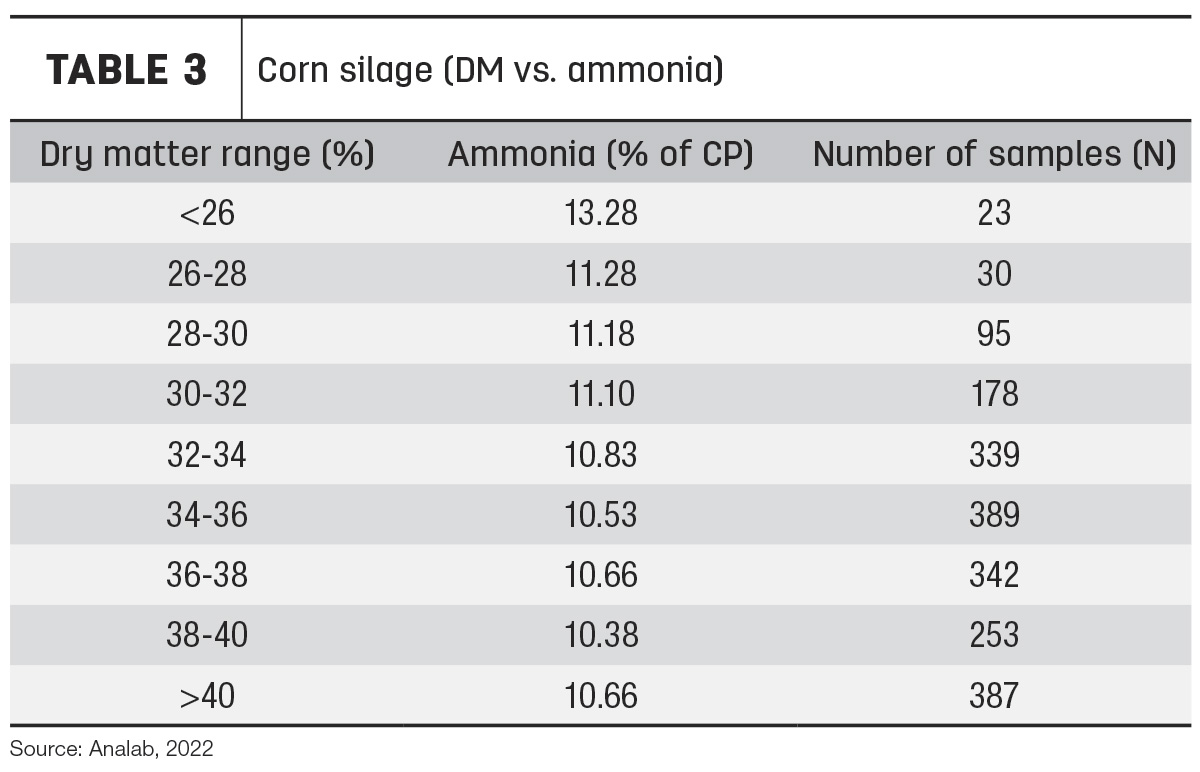Along with soluble proteins, amino acids, peptides and nitrate nitrogen, ammonia is part of the soluble protein (or ‘A’ fraction) of routine protein analysis and is generated by the deamination (removal of nitrogen-containing amino groups) of proteins, which reduces the overall quality of the protein. Ammonia is a source of nitrogen for rumen bacteria (in particular the cellulolytic bacteria), in which they can use ammonia nitrogen to generate amino acids used to synthesize bacterial protein. Should the ammonia concentration of forages get too high, there will be an energy and metabolic cost to the cattle that consume it.
There are some important items to remember with regard to ammonia and the dry matter (DM) content of forages. As forage DM increases (moisture decreases), the ammonia concentration of the forage decreases depending on protein content of the forage. An example of this can be seen in Tables 1, 2 and 3.


 00
00
Alfalfa haylage and grass silage (high-protein silages) will decrease in ammonia concentration as DM content increases, whereas there is little to no effect in corn silage (low-protein silage). Also, an increase in forage DM is accompanied with an increase in forage pH (less fermentation acids produced), allowing for more clostridia and proteolytic activity in the forage, which increases ammonia concentrations. This is exaggerated if dirt is brought into the forage during harvest because of increased clostridia counts. Application of manure/nitrogen close to harvesting will increase fermentable protein, causing an increase in ammonia concentrations.
Silage packed too loosely and filled too slowly tend to have elevated ammonia concentrations, which are considered elevated when they exceed 12% to 15% of the crude protein (DM basis) in a forage analysis. A rule of thumb when interpreting ammonia analysis on your forage reports is the following: Less than 12% of crude protein (CP) is desired, 12 to 15% of CP is slightly elevated, and greater than 15% of CP could be a potential issue that may need to be addressed.
High ammonia concentrations in forages alone are not a cause for alarm as long as the total nitrogen fractions in the diet are in balance. Ammonia enters the rumen directly from feed and is produced in the rumen from non-protein nitrogen sources (e.g., urea) and nitrates. Therefore, the total combined ammonia available to cattle must be considered when monitoring a diet for potential ammonia-related effects. If forage ammonia concentrations cause an increase in diet-soluble protein (or total rumen-degradable protein), then some negative effects can occur. Also, there needs to be consideration of the potential for biogenic amine compounds (putrescine, histamine and ethanolamine) that can be produced from the deamination of various amino acids along with ammonia.
If high-ammonia forages are fed, cattle need to be monitored because they can experience several negative effects from ammonia. Elevated blood urea nitrogen (BUN) or milk urea nitrogen (MUN) can be used as an indicator that blood ammonia concentrations are increasing. It is an energy-utilizing metabolic process to convert ammonia to urea, which can lead to loss of body condition and reduced production. Loose manure may also be an indicator that forages are contributing to an elevated ammonia concentration in the diet. Once in the blood, ammonia will increase the blood pH, which may lead to abortions, resorbed fetus and/or poor calf health. Monitoring urine pH in dairy cattle may allow early detection that the blood pH is increasing. Because ammonia can add an odor to the feed, as well as increase blood pH in cattle, it is common to see reduced dry matter intake with higher concentrations of ammonia in the diet. This will likely lead to reduced performance.
If ammonia concentrations in forage are high enough, more severe problems can arise such as pulmonary edema, abdominal pain, frothy salivation and gasping for breath. A central nervous system disorder, referred to as bovine bonkers, can develop which causes stampeding, ear twitching, trembling and convulsions. Typically, this would be more likely if cattle are fed ammoniated forages rather than from natural ammonia production within a silage.
It is the author’s opinion that elevated ammonia in forage is an indicator that a more serious problem may be prevalent: clostridia contamination. Clostridia is a bacteria that can contaminate forage if dirt is included during harvest. Clostridia will produce ammonia and butyric acid giving forage an off-putting odor that smells similar to manure. Various clostridial diseases (black leg, botulism, hemorrhagic bowel syndrome, etc.) can occur if cattle consume enough of the organism. These diseases are fatal if left unchecked.
Minimizing ammonia in fermented forages should be desired and can be managed by keeping some simple harvesting tips in mind. Harvesting forage at an optimal DM and maturity is the first step. Proper DM allows for an appropriate fermentation, allowing silage pH to drop and help stabilize the forage. Proper use of a silage additive will help to reduce silage pH and stabilize the forage. Avoid manure/nitrogen application during the growing season. This will allow nitrogen to accumulate in the plant (some nitrogen will be stored as nitrates, leading to ammonia formation in the rumen), increasing the risk of ammonia production during storage. Along with this, you want to minimize soil contamination during harvest, which will add clostridia to the stored silage. As mentioned earlier, clostridia will synthesize ammonia from plant protein and nitrogen. To ensure a proper fermentation, and help control the growth of clostridia in the silage, fill the silo quickly, pack tightly and cover immediately.
Should you find your forage has an elevated ammonia concentration, there are things to consider that can help reduce the concentration of ammonia and the issues that occur with livestock when that forage is consumed. Dilute or remove high-ammonia forage to minimize the amount of ammonia consumed by cattle. You can add a fermentable source of sugar (e.g., molasses) to the diet to assist the rumen bacteria in using ammonia as a source of nitrogen. There is a requirement by rumen microbes for ammonia, and fermentable sugars can provide the energy they need to convert ammonia into microbial nitrogen. Certainly reduce or remove urea and other non-protein nitrogen sources from the ration, as these will generate more ammonia in the rumen.
Taking precautions at harvest, controlling the amount of ammonia in a diet and monitoring cattle to determine if they are being fed too much ammonia can help to manage the forage you have. Work with your agronomy and nutrition professionals to determine the best approach to minimize ammonia in forages and to utilize the forages you have in the best possible way to minimize effects of ammonia on your cattle.
References omitted but are available upon request by sending an email to the editor.









